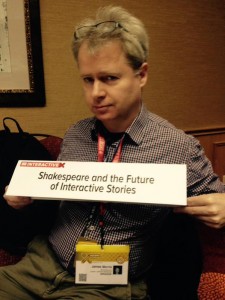 This is now the third year that I’ve taken a student trip to the SXSW Interactive event in Austin, Texas. However, this year was a little different. The panel I put forward last year had been accepted, so I was going to be a speaker as well as an attendee. This was a pretty daunting prospect, considering how many thousands suggest panels and how few of them end up being accepted in the end. Luckily, I was going to be aided by the Royal Shakespeare Company‘s Head of Digital Development, Sarah Ellis, who was going to contribute insight from some other RSC projects she had worked on, in particular Midsummer Night’s Dreaming to complement my discussions of the RSC-Ravensboure collaboration I had been part of since the end of 2011.
This is now the third year that I’ve taken a student trip to the SXSW Interactive event in Austin, Texas. However, this year was a little different. The panel I put forward last year had been accepted, so I was going to be a speaker as well as an attendee. This was a pretty daunting prospect, considering how many thousands suggest panels and how few of them end up being accepted in the end. Luckily, I was going to be aided by the Royal Shakespeare Company‘s Head of Digital Development, Sarah Ellis, who was going to contribute insight from some other RSC projects she had worked on, in particular Midsummer Night’s Dreaming to complement my discussions of the RSC-Ravensboure collaboration I had been part of since the end of 2011.
 SXSW, or “South By” as it’s known to friends, has grown organically over its 28 years from a music festival in 1987, to a film and multimedia event in 1994, and then three separate, overlapping festivals a year later. It has remained in this form for the last two decades. The trio of themes are clearly related – they cover most of the important elements of current media, with the exception of TV, although that gets covered in the Film and Interactive sections anyway. But the type of attendee does noticeably change halfway through, when the interactive hipsters are replaced by musical subcultural types, and the focus switches from the Convention Center to a myriad grungy venues across Austin.
SXSW, or “South By” as it’s known to friends, has grown organically over its 28 years from a music festival in 1987, to a film and multimedia event in 1994, and then three separate, overlapping festivals a year later. It has remained in this form for the last two decades. The trio of themes are clearly related – they cover most of the important elements of current media, with the exception of TV, although that gets covered in the Film and Interactive sections anyway. But the type of attendee does noticeably change halfway through, when the interactive hipsters are replaced by musical subcultural types, and the focus switches from the Convention Center to a myriad grungy venues across Austin.
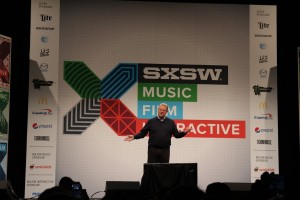 A brief rundown of some of the sessions I attended will illustrate just how much variety there can be at SXSW Interactive, and this is just a drop in the ocean compared to the huge range of sessions availab.e. On the first day I attended a keynote session by Al Gore, presenting his usual slick arguments about global warming. Except this time the message seemed a little more positive, as spending on renewables is growing well beyond everyone’s previous expectations, with 12 times the predicted spend on wind and 17 times that on solar. The best message of all was that Warren Buffett has pulled investment from fossil fuels and put $30 billion into solar instead. Maybe we are headed for a sunnier future in energy production than we might have thought possible a few years ago.
A brief rundown of some of the sessions I attended will illustrate just how much variety there can be at SXSW Interactive, and this is just a drop in the ocean compared to the huge range of sessions availab.e. On the first day I attended a keynote session by Al Gore, presenting his usual slick arguments about global warming. Except this time the message seemed a little more positive, as spending on renewables is growing well beyond everyone’s previous expectations, with 12 times the predicted spend on wind and 17 times that on solar. The best message of all was that Warren Buffett has pulled investment from fossil fuels and put $30 billion into solar instead. Maybe we are headed for a sunnier future in energy production than we might have thought possible a few years ago.
 One of my favourite sessions was the keynote by Jonah Peretti, founder of BuzzFeed and before that Huffington Post. He presented a very clear account of why posting natively on social networks rather than via links provides a significant increase in engagement. The number of impressions for a piece of content embedded in the streams of Twitter, Pinterest and Facebook dwarfed the number of clicks back to the main Buzzfeed site – 420 million direct links compared to 18 billion impressions. So BuzzFeed’s strategy is to create content that can be reconfigured so that it can be posted in different formats that fit host streams and sit in these natively. This strategy is most infamously represented by the BuzzFeed Obama selfie stick videos, which was on Facebook in Facebook’s native video player, but shorter Vine and Gif versions were also spread across various Internet conduits. In contrast, BuzzFeed has allegedly resisted offers to create content for traditional broadcast media, because of the lack of data about how people view that is available from these channels. Scientific hypothesis testing is a virtually universal element in successful Internet businesses.
One of my favourite sessions was the keynote by Jonah Peretti, founder of BuzzFeed and before that Huffington Post. He presented a very clear account of why posting natively on social networks rather than via links provides a significant increase in engagement. The number of impressions for a piece of content embedded in the streams of Twitter, Pinterest and Facebook dwarfed the number of clicks back to the main Buzzfeed site – 420 million direct links compared to 18 billion impressions. So BuzzFeed’s strategy is to create content that can be reconfigured so that it can be posted in different formats that fit host streams and sit in these natively. This strategy is most infamously represented by the BuzzFeed Obama selfie stick videos, which was on Facebook in Facebook’s native video player, but shorter Vine and Gif versions were also spread across various Internet conduits. In contrast, BuzzFeed has allegedly resisted offers to create content for traditional broadcast media, because of the lack of data about how people view that is available from these channels. Scientific hypothesis testing is a virtually universal element in successful Internet businesses.
 Thanks to my Speaker status, I was able to attend SXSW Film sessions as well. I saw Alex Garland discuss the nature of artificial intelligence, as presented by his recent film Ex Machina. I really didn’t expect to get into a heavy philosophical discussion about AI before the panel had even begun, with an Austrian filmmaker who happened to sit down next to me – although this is just the kind of experience you will have at SXSW, because networking of every sort is what people go there for. In fact, AI was a bit of a sub-theme at SXSW 2015 in general, with quite a number of talks revolving around the topic.
Thanks to my Speaker status, I was able to attend SXSW Film sessions as well. I saw Alex Garland discuss the nature of artificial intelligence, as presented by his recent film Ex Machina. I really didn’t expect to get into a heavy philosophical discussion about AI before the panel had even begun, with an Austrian filmmaker who happened to sit down next to me – although this is just the kind of experience you will have at SXSW, because networking of every sort is what people go there for. In fact, AI was a bit of a sub-theme at SXSW 2015 in general, with quite a number of talks revolving around the topic.
 NASA was very much in evidence, as in previous years that I have attended. They gave an amazing presentation about how they visualised astronomical data, filling in the gaps to make the most engaging animations of what telescopes were picking up. The talk was capped by the announcement that the Hubble 3D film was going to be released in April to commemorate the telescope’s 25 years. However, alongside a talk showing some of the amazing shots of Earth that have been taken from the International Space Station, astronaut Don Pettit announced that footage and images were available online for free usage and there was to be a filmmaking competition to see who could produce the best videos out of the NASA footage, with prizes up to $10,000 on offer. Details are available at http://cinespace15.org/.
NASA was very much in evidence, as in previous years that I have attended. They gave an amazing presentation about how they visualised astronomical data, filling in the gaps to make the most engaging animations of what telescopes were picking up. The talk was capped by the announcement that the Hubble 3D film was going to be released in April to commemorate the telescope’s 25 years. However, alongside a talk showing some of the amazing shots of Earth that have been taken from the International Space Station, astronaut Don Pettit announced that footage and images were available online for free usage and there was to be a filmmaking competition to see who could produce the best videos out of the NASA footage, with prizes up to $10,000 on offer. Details are available at http://cinespace15.org/.
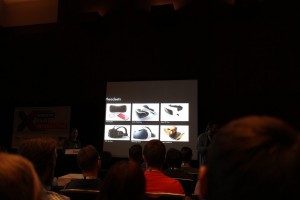 Innovations in audivisual production and distribution make up the main area of my academic and practical interest, so these featured heavily in my session schedule. The event detailing three films made with the Jaunt 360-degree camera gave a fascinating insight into making movies with fully immersive visuals. The films were Black Mass, The Mission, and Kaiju Fury. In some ways, shooting 360 could be a gimmick like 3D. But in tandem with the explosion in VR headsets instigated by Oculus Rift, there is plenty of potential for fun experimentation here.
Innovations in audivisual production and distribution make up the main area of my academic and practical interest, so these featured heavily in my session schedule. The event detailing three films made with the Jaunt 360-degree camera gave a fascinating insight into making movies with fully immersive visuals. The films were Black Mass, The Mission, and Kaiju Fury. In some ways, shooting 360 could be a gimmick like 3D. But in tandem with the explosion in VR headsets instigated by Oculus Rift, there is plenty of potential for fun experimentation here.
 The team doing marketing for Game of Thrones discussed their engagement strategies, culminating in the most recent campaign, “The Sight”. Those who signed up on this website were sent a series of videos that literally disappeared 90 seconds after you first tried to watch them, which people didn’t realise the first time round and this made many of them rather angry. But it also made them talk about the experience, so by the end of the campaign there had been 1,375,000 site visitors, 47 million page impressions, and 664,000 videos viewed. Watching the buzz on Bottlenose, the team saw noticeable spikes (or “blooms”) on social media for a couple of days after the release of each video, and a sub-phenomenon of people recording their reactions to the videos. The main takeout from the session was that the richness of the Game of Thrones storyworld was the enabling factor behind this kind of marketing ploy.
The team doing marketing for Game of Thrones discussed their engagement strategies, culminating in the most recent campaign, “The Sight”. Those who signed up on this website were sent a series of videos that literally disappeared 90 seconds after you first tried to watch them, which people didn’t realise the first time round and this made many of them rather angry. But it also made them talk about the experience, so by the end of the campaign there had been 1,375,000 site visitors, 47 million page impressions, and 664,000 videos viewed. Watching the buzz on Bottlenose, the team saw noticeable spikes (or “blooms”) on social media for a couple of days after the release of each video, and a sub-phenomenon of people recording their reactions to the videos. The main takeout from the session was that the richness of the Game of Thrones storyworld was the enabling factor behind this kind of marketing ploy.
 I must admit that I try to indulge in my fair share of hero worship at SXSW, as there are usually some pretty big names in attendance. The Ryan Gosling / Guillermo Del Toro event had a line longer than a Russian meat queue, so I didn’t bother with that. But I did see Harvard Law professor Lawrence Lessig (his Code 2.0 is one of the great analytical texts of the Internet era), Malcolm Gladwell and Henry Rollins. None of them imparted any earth-shattering insight beyond what you might already know if you were familiar with them (particularly Gladwell, as he was the interviewer rather than interviewee). But Eric Ries, whose Lean Startup is the bible of digital entrepreneurship, launched a Kickstarter for his new book that had virtually received its $135,000 goal by the end of the day, and had hit well over half a million by the time the pledge period had finished a month later.
I must admit that I try to indulge in my fair share of hero worship at SXSW, as there are usually some pretty big names in attendance. The Ryan Gosling / Guillermo Del Toro event had a line longer than a Russian meat queue, so I didn’t bother with that. But I did see Harvard Law professor Lawrence Lessig (his Code 2.0 is one of the great analytical texts of the Internet era), Malcolm Gladwell and Henry Rollins. None of them imparted any earth-shattering insight beyond what you might already know if you were familiar with them (particularly Gladwell, as he was the interviewer rather than interviewee). But Eric Ries, whose Lean Startup is the bible of digital entrepreneurship, launched a Kickstarter for his new book that had virtually received its $135,000 goal by the end of the day, and had hit well over half a million by the time the pledge period had finished a month later.
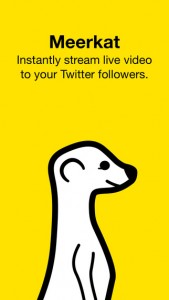 There’s always a central fad at SXSW. In 2007 it was the coming of age of Twitter. In 2014 it was Google Glass. In 2015 it was the live mobile video sharing utility, Meerkat. However, in his SXSWi 2015 keynote, the head of Google Moonshots, Astro Teller, was grouping Glass amongst a whole list of productive failures his Google[x] division had created, alongside the tail sitter that prefigured the more conventional drone delivery systems now being considered. And just a few weeks after SXSW was over, Meerkat has already had its thunder stolen by Periscope, which does pretty much the same thing as Meerkat, but has much greater chance of success as it’s now owned by Twitter itself. Either way, I’m not sure the way Meerkat was being used at SXSW was doing its image any good. My first encounter with Meerkat was in the queue for registration at SXSW, where the guy in front of me was broadcasting every detail of himself receiving his badge. I’m sure even his next of kin were rolling their eyes and muttering “Really?”
There’s always a central fad at SXSW. In 2007 it was the coming of age of Twitter. In 2014 it was Google Glass. In 2015 it was the live mobile video sharing utility, Meerkat. However, in his SXSWi 2015 keynote, the head of Google Moonshots, Astro Teller, was grouping Glass amongst a whole list of productive failures his Google[x] division had created, alongside the tail sitter that prefigured the more conventional drone delivery systems now being considered. And just a few weeks after SXSW was over, Meerkat has already had its thunder stolen by Periscope, which does pretty much the same thing as Meerkat, but has much greater chance of success as it’s now owned by Twitter itself. Either way, I’m not sure the way Meerkat was being used at SXSW was doing its image any good. My first encounter with Meerkat was in the queue for registration at SXSW, where the guy in front of me was broadcasting every detail of himself receiving his badge. I’m sure even his next of kin were rolling their eyes and muttering “Really?”
Related Posts




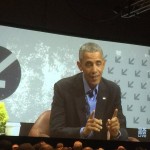

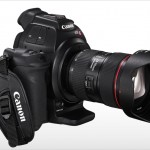
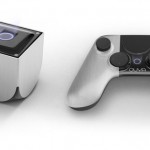

Finally got my blog post up about some of the sessions I attended at SXSW 2015, including my own! http://t.co/FvZLOQhBE5 #sxsw #ravesxsw
RT @Cyberwest: Finally got my blog post up about some of the sessions I attended at SXSW 2015, including my own! http://t.co/FvZLOQhBE5 #sx…